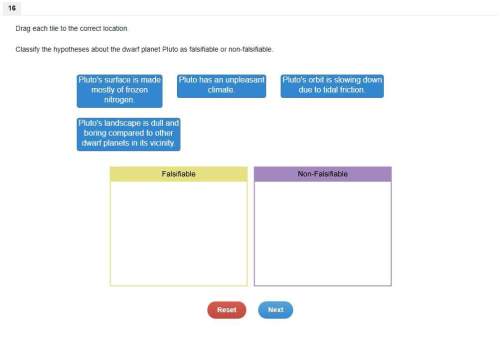
A parallel-plate capacitor having circular plates of radius R and separation d is charged to a potential difference by a battery. It is then removed from the battery. If the plates are moved closer together (there may be more than one correct choice),
A. the amount of charge on each of them will increase
B. the amount of charge on each of them will decrease
C. the amount of charge on each of them will stay the same
D. the energy stored in the capacitor increases

Answers: 1
Another question on Physics

Physics, 21.06.2019 22:00
There is a theory that indicates that dinosaurs became extinct when about 65 million years ago, a large asteroid hit the earth surface. dust caused by this collision blocked the sunlight reaching the earth's surface and many forms of life became extinct due to the cold. fearing this threat, how large the radius of an asteroid should you be looking for if the dangerous asteroid size is approximately the same as the one that killed the dinosaurs? available data suggests that about 18% of that asteroid's mass ended up as a dust spread evenly over earth after eventually settling out of the upper atmosphere. about 0.0180 g/cm^2 of dust, which is chemically different than the earth's rock, covered the earth's surface. typical asteroids have a density of about 1.9 g/cm^3. now that we know the size of the asteroid, how much energy was released during impact, assuming all of it was just the kinetic energy of the asteroid right before the impact?
Answers: 1

Physics, 22.06.2019 02:10
Astudent is performing an experiment comparing sound and light waves. the student gathers the following data. what conclusion does the student most likely make based on this data? light waves always travel the same speed; however, the speed of sound is determined by the medium that it travels through. all sound waves always have the same energy, so the temperature of the medium does not affect wave speed. light needs to vibrate particles, so it travels fastest in tightly packed solids, while sound does not need a medium, so it travels fastest in a gas. tightly packed particles in solids slow down the light waves; however, sound waves make particles bounce into each other, so they travel faster in solids.
Answers: 3

Physics, 22.06.2019 11:00
Engineers find a new metal that is stronger than steel but much lighter. this material is also significantly cheaper than what is currently used for most aircraft, available in large quantities, and easy to manufacture. the engineers are excited because this new material will lower the costs of buying and operating airplanes for companies. what is probably the best step for the engineers to make next?
Answers: 2

Physics, 22.06.2019 17:30
Asilver dollar is dropped from the top of a building that is 1324 feet tall. use the position function below for free-falling objects. s(t) = −16t2 + v0t + s0 (a) determine the position and velocity functions for the coin. s(t) = v(t) = (b) determine the average velocity on the interval [1, 2]. ft/s (c) find the instantaneous velocities when t = 1 second and t = 2 seconds. v(1) = ft/s v(2) = ft/s (d) find the time required for the coin to reach the ground level. (round your answer to three decimal places.) t = s (e) find the velocity of the coin at impact. (round your answer to three decimal places.) ft/s
Answers: 3
You know the right answer?
A parallel-plate capacitor having circular plates of radius R and separation d is charged to a poten...
Questions



Mathematics, 24.11.2019 04:31

English, 24.11.2019 04:31




Mathematics, 24.11.2019 04:31



History, 24.11.2019 04:31


Mathematics, 24.11.2019 04:31

Biology, 24.11.2019 04:31

History, 24.11.2019 04:31

Mathematics, 24.11.2019 04:31



Mathematics, 24.11.2019 04:31

Mathematics, 24.11.2019 04:31




